An Analysis of Australian Healthcare Reform and Digital Strategy
VerifiedAdded on 2021/09/13
|11
|2337
|319
Report
AI Summary
This report provides an in-depth analysis of the Australian healthcare reform, specifically focusing on the digital healthcare strategy implemented by the government. The report highlights the objectives of the reform, which include improving healthcare quality, reducing costs, and enhancing accessibility for all citizens. It details the strategies employed for successful implementation, such as collaboration with various stakeholders, empowerment through innovation, and a focus on patient data safety. The role of the Australian Digital Health Agency is also discussed. Furthermore, the report identifies opportunities for future policy reform, including collaborations with institutions of higher learning and other industries, and increasing public awareness. The report concludes with a summary of the key findings and recommendations for continued progress in digital healthcare within Australia. The assignment is available on Desklib, a platform offering AI-based study tools.

HEALTH REFORM AND ORGANIZATION GOVERNANCE
Name
Institutional Affiliation
Date
Name
Institutional Affiliation
Date
Paraphrase This Document
Need a fresh take? Get an instant paraphrase of this document with our AI Paraphraser
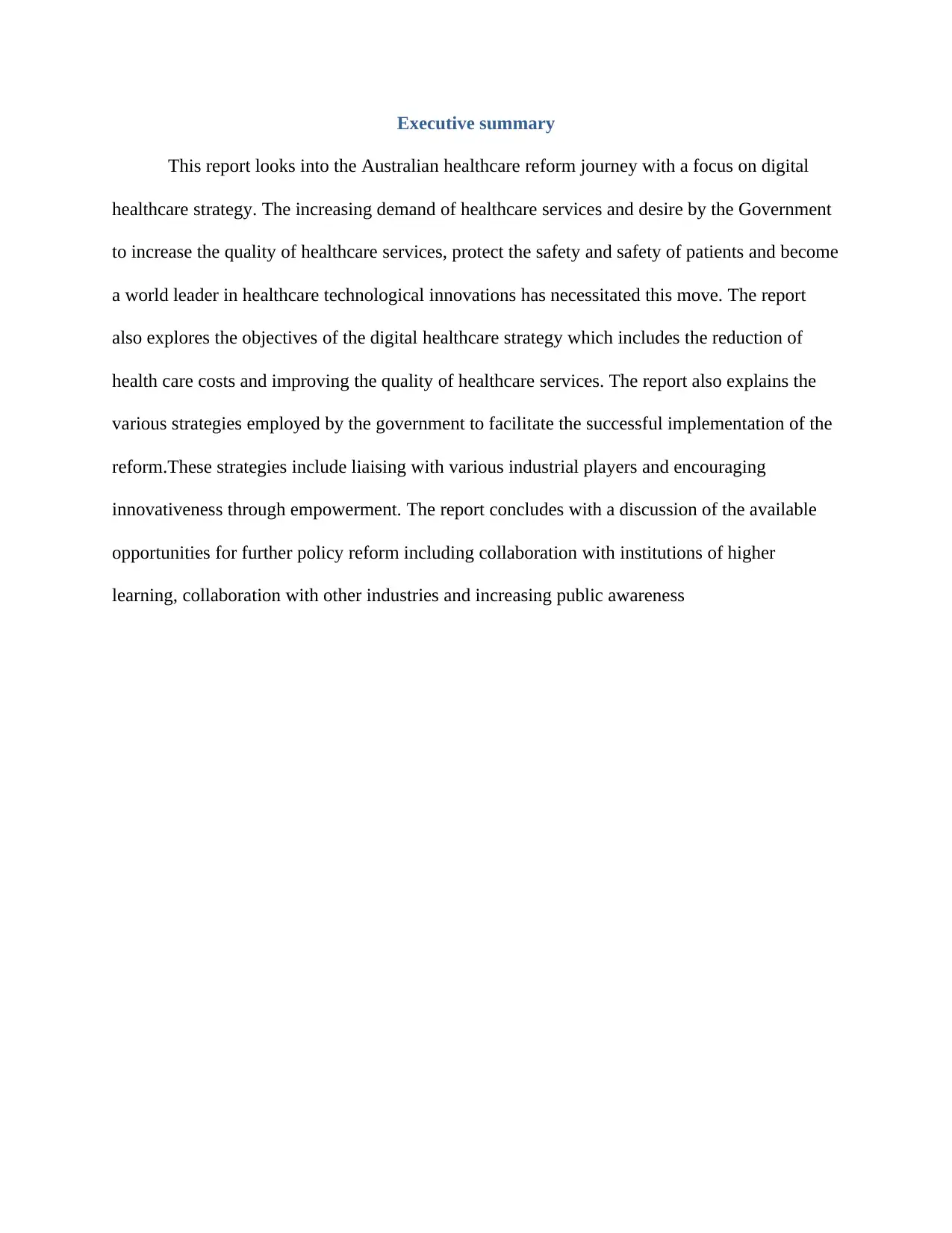
Executive summary
This report looks into the Australian healthcare reform journey with a focus on digital
healthcare strategy. The increasing demand of healthcare services and desire by the Government
to increase the quality of healthcare services, protect the safety and safety of patients and become
a world leader in healthcare technological innovations has necessitated this move. The report
also explores the objectives of the digital healthcare strategy which includes the reduction of
health care costs and improving the quality of healthcare services. The report also explains the
various strategies employed by the government to facilitate the successful implementation of the
reform.These strategies include liaising with various industrial players and encouraging
innovativeness through empowerment. The report concludes with a discussion of the available
opportunities for further policy reform including collaboration with institutions of higher
learning, collaboration with other industries and increasing public awareness
This report looks into the Australian healthcare reform journey with a focus on digital
healthcare strategy. The increasing demand of healthcare services and desire by the Government
to increase the quality of healthcare services, protect the safety and safety of patients and become
a world leader in healthcare technological innovations has necessitated this move. The report
also explores the objectives of the digital healthcare strategy which includes the reduction of
health care costs and improving the quality of healthcare services. The report also explains the
various strategies employed by the government to facilitate the successful implementation of the
reform.These strategies include liaising with various industrial players and encouraging
innovativeness through empowerment. The report concludes with a discussion of the available
opportunities for further policy reform including collaboration with institutions of higher
learning, collaboration with other industries and increasing public awareness
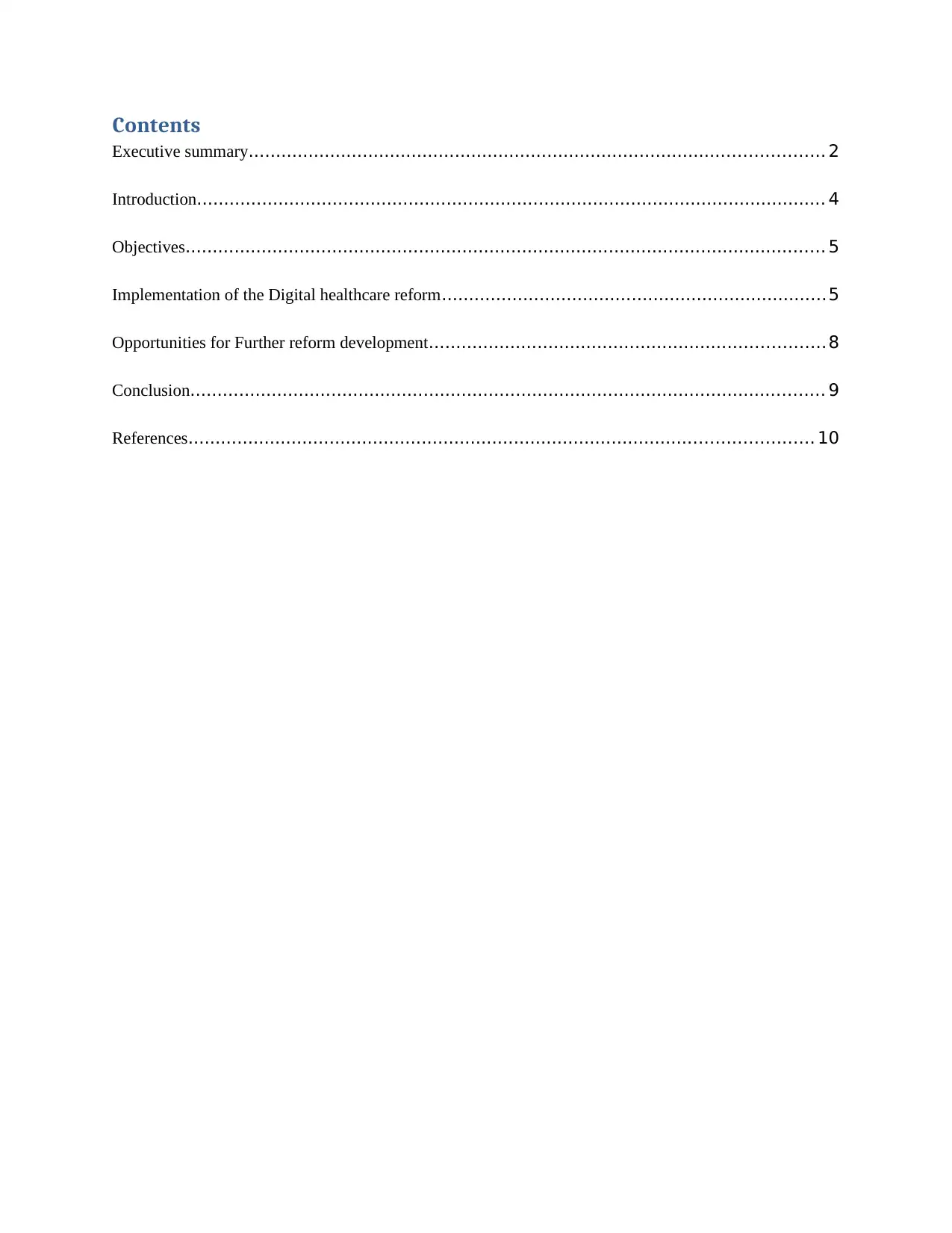
Contents
Executive summary.......................................................................................................... 2
Introduction.................................................................................................................... 4
Objectives...................................................................................................................... 5
Implementation of the Digital healthcare reform.......................................................................5
Opportunities for Further reform development.........................................................................8
Conclusion..................................................................................................................... 9
References................................................................................................................... 10
Executive summary.......................................................................................................... 2
Introduction.................................................................................................................... 4
Objectives...................................................................................................................... 5
Implementation of the Digital healthcare reform.......................................................................5
Opportunities for Further reform development.........................................................................8
Conclusion..................................................................................................................... 9
References................................................................................................................... 10
⊘ This is a preview!⊘
Do you want full access?
Subscribe today to unlock all pages.

Trusted by 1+ million students worldwide
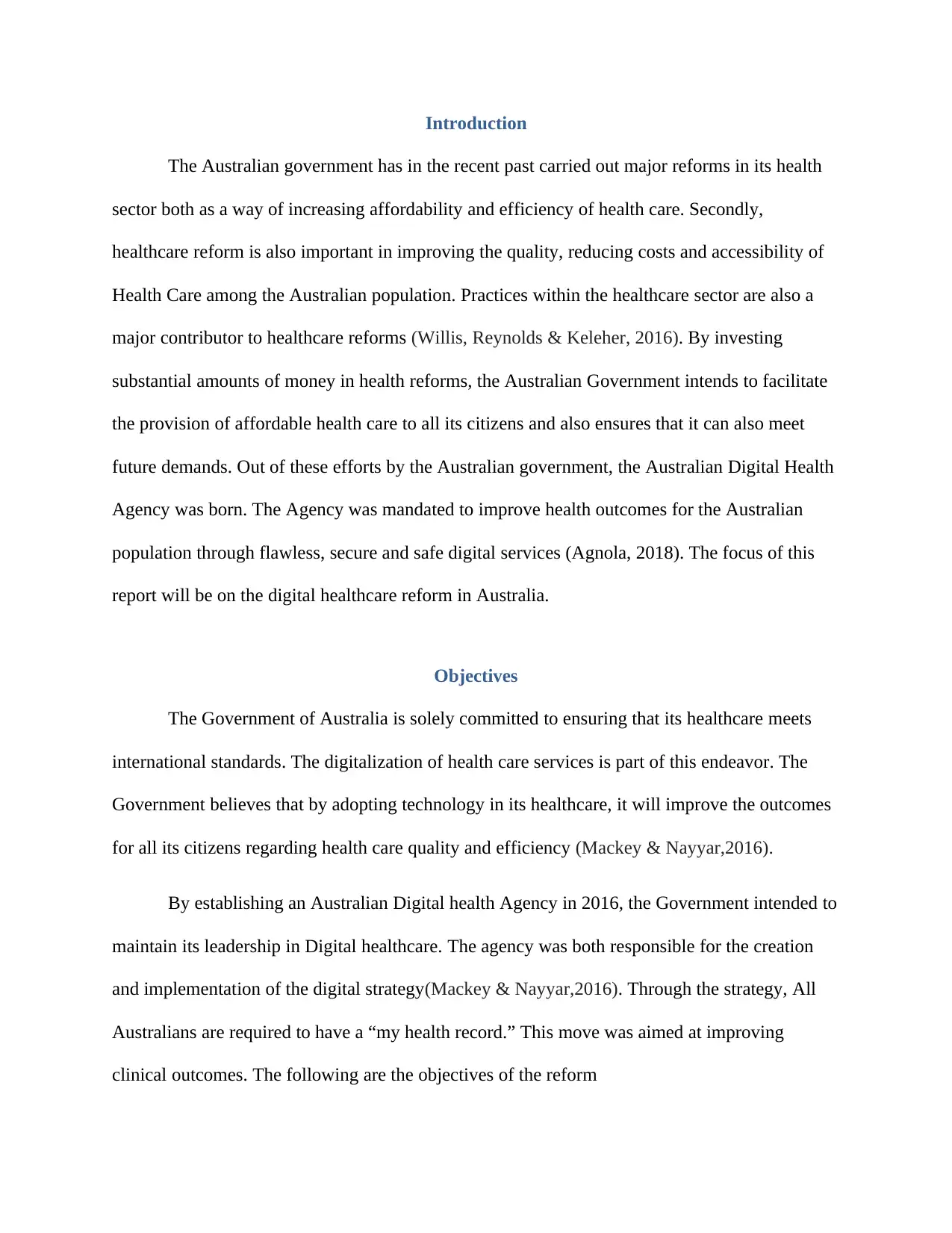
Introduction
The Australian government has in the recent past carried out major reforms in its health
sector both as a way of increasing affordability and efficiency of health care. Secondly,
healthcare reform is also important in improving the quality, reducing costs and accessibility of
Health Care among the Australian population. Practices within the healthcare sector are also a
major contributor to healthcare reforms (Willis, Reynolds & Keleher, 2016). By investing
substantial amounts of money in health reforms, the Australian Government intends to facilitate
the provision of affordable health care to all its citizens and also ensures that it can also meet
future demands. Out of these efforts by the Australian government, the Australian Digital Health
Agency was born. The Agency was mandated to improve health outcomes for the Australian
population through flawless, secure and safe digital services (Agnola, 2018). The focus of this
report will be on the digital healthcare reform in Australia.
Objectives
The Government of Australia is solely committed to ensuring that its healthcare meets
international standards. The digitalization of health care services is part of this endeavor. The
Government believes that by adopting technology in its healthcare, it will improve the outcomes
for all its citizens regarding health care quality and efficiency (Mackey & Nayyar,2016).
By establishing an Australian Digital health Agency in 2016, the Government intended to
maintain its leadership in Digital healthcare. The agency was both responsible for the creation
and implementation of the digital strategy(Mackey & Nayyar,2016). Through the strategy, All
Australians are required to have a “my health record.” This move was aimed at improving
clinical outcomes. The following are the objectives of the reform
The Australian government has in the recent past carried out major reforms in its health
sector both as a way of increasing affordability and efficiency of health care. Secondly,
healthcare reform is also important in improving the quality, reducing costs and accessibility of
Health Care among the Australian population. Practices within the healthcare sector are also a
major contributor to healthcare reforms (Willis, Reynolds & Keleher, 2016). By investing
substantial amounts of money in health reforms, the Australian Government intends to facilitate
the provision of affordable health care to all its citizens and also ensures that it can also meet
future demands. Out of these efforts by the Australian government, the Australian Digital Health
Agency was born. The Agency was mandated to improve health outcomes for the Australian
population through flawless, secure and safe digital services (Agnola, 2018). The focus of this
report will be on the digital healthcare reform in Australia.
Objectives
The Government of Australia is solely committed to ensuring that its healthcare meets
international standards. The digitalization of health care services is part of this endeavor. The
Government believes that by adopting technology in its healthcare, it will improve the outcomes
for all its citizens regarding health care quality and efficiency (Mackey & Nayyar,2016).
By establishing an Australian Digital health Agency in 2016, the Government intended to
maintain its leadership in Digital healthcare. The agency was both responsible for the creation
and implementation of the digital strategy(Mackey & Nayyar,2016). Through the strategy, All
Australians are required to have a “my health record.” This move was aimed at improving
clinical outcomes. The following are the objectives of the reform
Paraphrase This Document
Need a fresh take? Get an instant paraphrase of this document with our AI Paraphraser
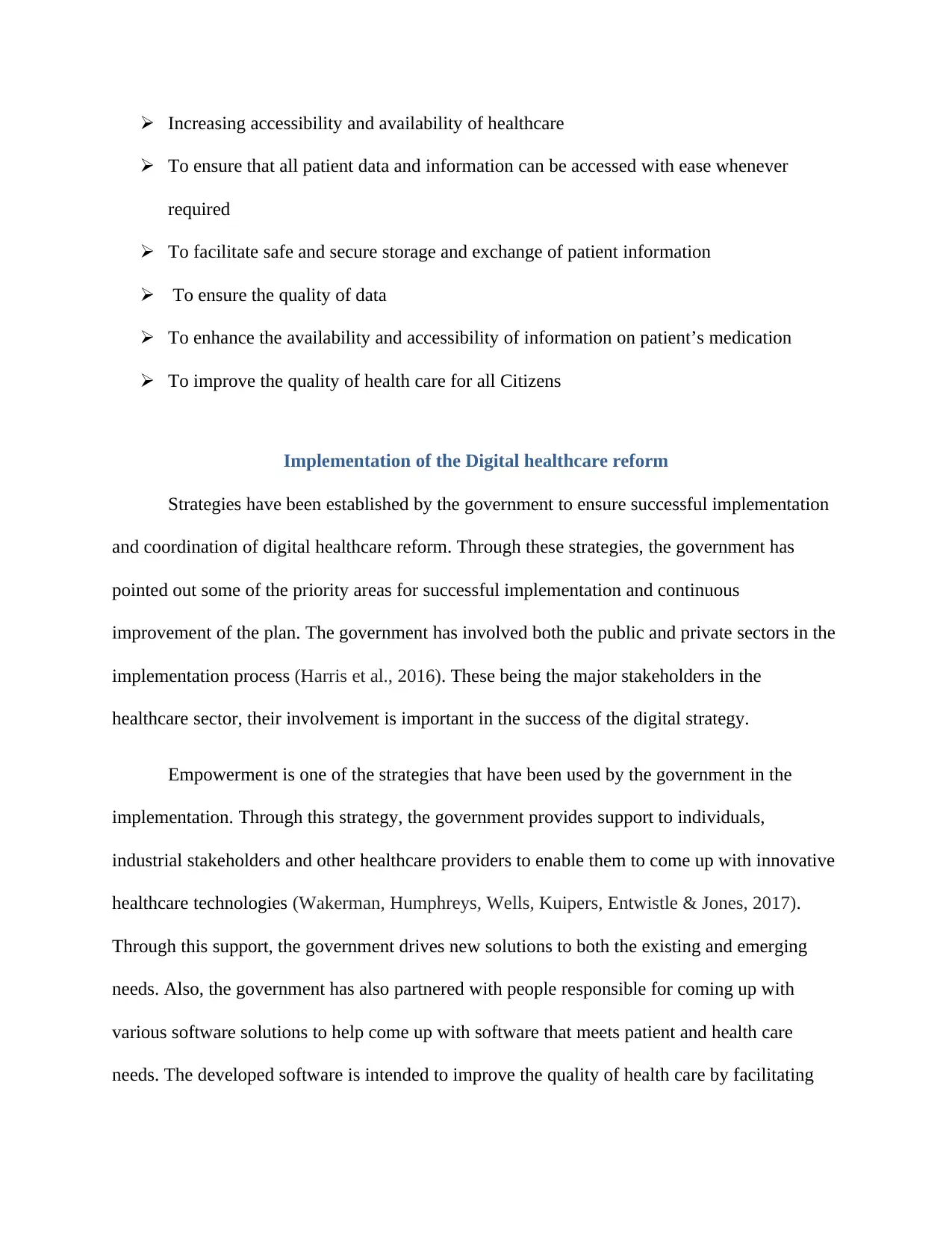
Increasing accessibility and availability of healthcare
To ensure that all patient data and information can be accessed with ease whenever
required
To facilitate safe and secure storage and exchange of patient information
To ensure the quality of data
To enhance the availability and accessibility of information on patient’s medication
To improve the quality of health care for all Citizens
Implementation of the Digital healthcare reform
Strategies have been established by the government to ensure successful implementation
and coordination of digital healthcare reform. Through these strategies, the government has
pointed out some of the priority areas for successful implementation and continuous
improvement of the plan. The government has involved both the public and private sectors in the
implementation process (Harris et al., 2016). These being the major stakeholders in the
healthcare sector, their involvement is important in the success of the digital strategy.
Empowerment is one of the strategies that have been used by the government in the
implementation. Through this strategy, the government provides support to individuals,
industrial stakeholders and other healthcare providers to enable them to come up with innovative
healthcare technologies (Wakerman, Humphreys, Wells, Kuipers, Entwistle & Jones, 2017).
Through this support, the government drives new solutions to both the existing and emerging
needs. Also, the government has also partnered with people responsible for coming up with
various software solutions to help come up with software that meets patient and health care
needs. The developed software is intended to improve the quality of health care by facilitating
To ensure that all patient data and information can be accessed with ease whenever
required
To facilitate safe and secure storage and exchange of patient information
To ensure the quality of data
To enhance the availability and accessibility of information on patient’s medication
To improve the quality of health care for all Citizens
Implementation of the Digital healthcare reform
Strategies have been established by the government to ensure successful implementation
and coordination of digital healthcare reform. Through these strategies, the government has
pointed out some of the priority areas for successful implementation and continuous
improvement of the plan. The government has involved both the public and private sectors in the
implementation process (Harris et al., 2016). These being the major stakeholders in the
healthcare sector, their involvement is important in the success of the digital strategy.
Empowerment is one of the strategies that have been used by the government in the
implementation. Through this strategy, the government provides support to individuals,
industrial stakeholders and other healthcare providers to enable them to come up with innovative
healthcare technologies (Wakerman, Humphreys, Wells, Kuipers, Entwistle & Jones, 2017).
Through this support, the government drives new solutions to both the existing and emerging
needs. Also, the government has also partnered with people responsible for coming up with
various software solutions to help come up with software that meets patient and health care
needs. The developed software is intended to improve the quality of health care by facilitating
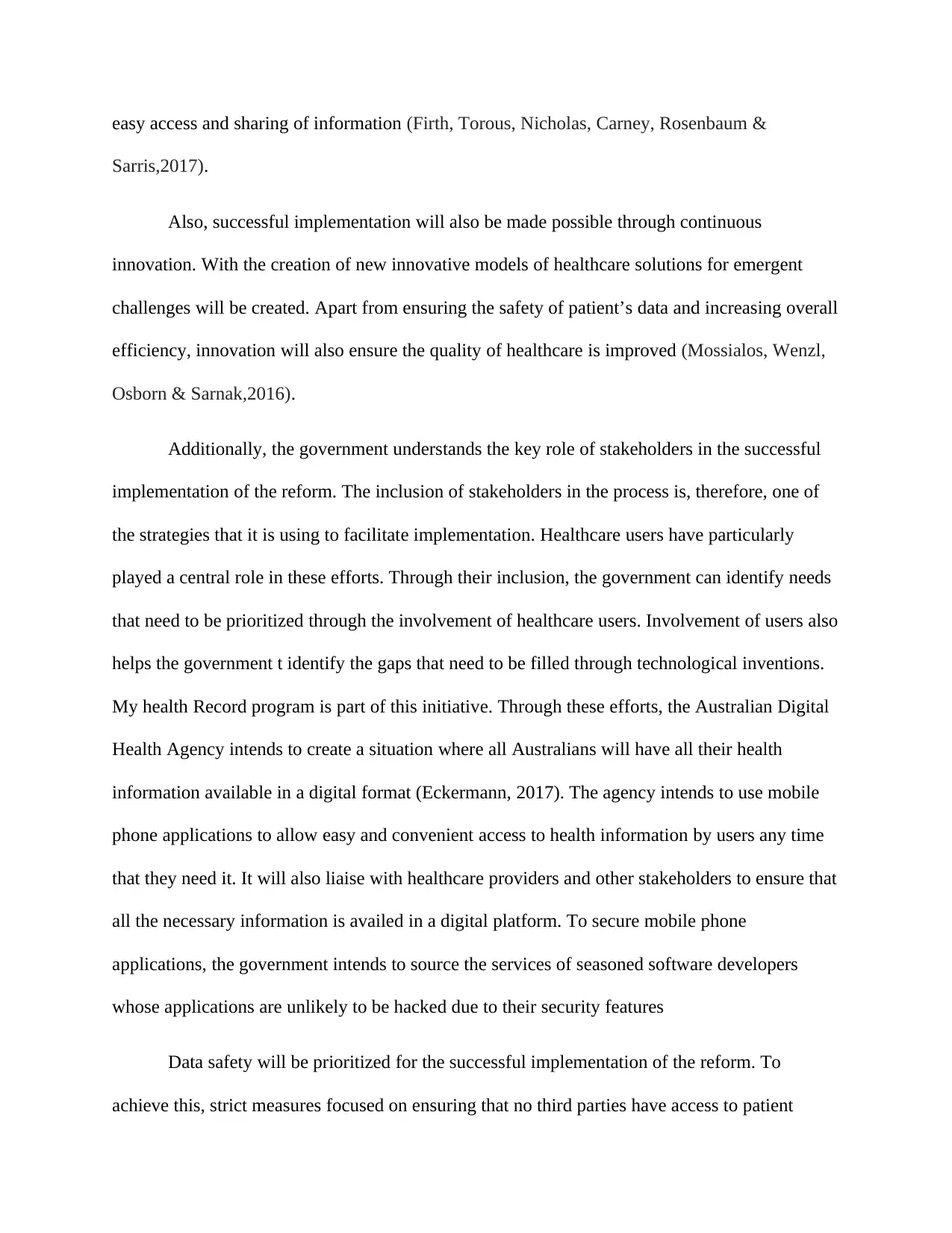
easy access and sharing of information (Firth, Torous, Nicholas, Carney, Rosenbaum &
Sarris,2017).
Also, successful implementation will also be made possible through continuous
innovation. With the creation of new innovative models of healthcare solutions for emergent
challenges will be created. Apart from ensuring the safety of patient’s data and increasing overall
efficiency, innovation will also ensure the quality of healthcare is improved (Mossialos, Wenzl,
Osborn & Sarnak,2016).
Additionally, the government understands the key role of stakeholders in the successful
implementation of the reform. The inclusion of stakeholders in the process is, therefore, one of
the strategies that it is using to facilitate implementation. Healthcare users have particularly
played a central role in these efforts. Through their inclusion, the government can identify needs
that need to be prioritized through the involvement of healthcare users. Involvement of users also
helps the government t identify the gaps that need to be filled through technological inventions.
My health Record program is part of this initiative. Through these efforts, the Australian Digital
Health Agency intends to create a situation where all Australians will have all their health
information available in a digital format (Eckermann, 2017). The agency intends to use mobile
phone applications to allow easy and convenient access to health information by users any time
that they need it. It will also liaise with healthcare providers and other stakeholders to ensure that
all the necessary information is availed in a digital platform. To secure mobile phone
applications, the government intends to source the services of seasoned software developers
whose applications are unlikely to be hacked due to their security features
Data safety will be prioritized for the successful implementation of the reform. To
achieve this, strict measures focused on ensuring that no third parties have access to patient
Sarris,2017).
Also, successful implementation will also be made possible through continuous
innovation. With the creation of new innovative models of healthcare solutions for emergent
challenges will be created. Apart from ensuring the safety of patient’s data and increasing overall
efficiency, innovation will also ensure the quality of healthcare is improved (Mossialos, Wenzl,
Osborn & Sarnak,2016).
Additionally, the government understands the key role of stakeholders in the successful
implementation of the reform. The inclusion of stakeholders in the process is, therefore, one of
the strategies that it is using to facilitate implementation. Healthcare users have particularly
played a central role in these efforts. Through their inclusion, the government can identify needs
that need to be prioritized through the involvement of healthcare users. Involvement of users also
helps the government t identify the gaps that need to be filled through technological inventions.
My health Record program is part of this initiative. Through these efforts, the Australian Digital
Health Agency intends to create a situation where all Australians will have all their health
information available in a digital format (Eckermann, 2017). The agency intends to use mobile
phone applications to allow easy and convenient access to health information by users any time
that they need it. It will also liaise with healthcare providers and other stakeholders to ensure that
all the necessary information is availed in a digital platform. To secure mobile phone
applications, the government intends to source the services of seasoned software developers
whose applications are unlikely to be hacked due to their security features
Data safety will be prioritized for the successful implementation of the reform. To
achieve this, strict measures focused on ensuring that no third parties have access to patient
⊘ This is a preview!⊘
Do you want full access?
Subscribe today to unlock all pages.

Trusted by 1+ million students worldwide
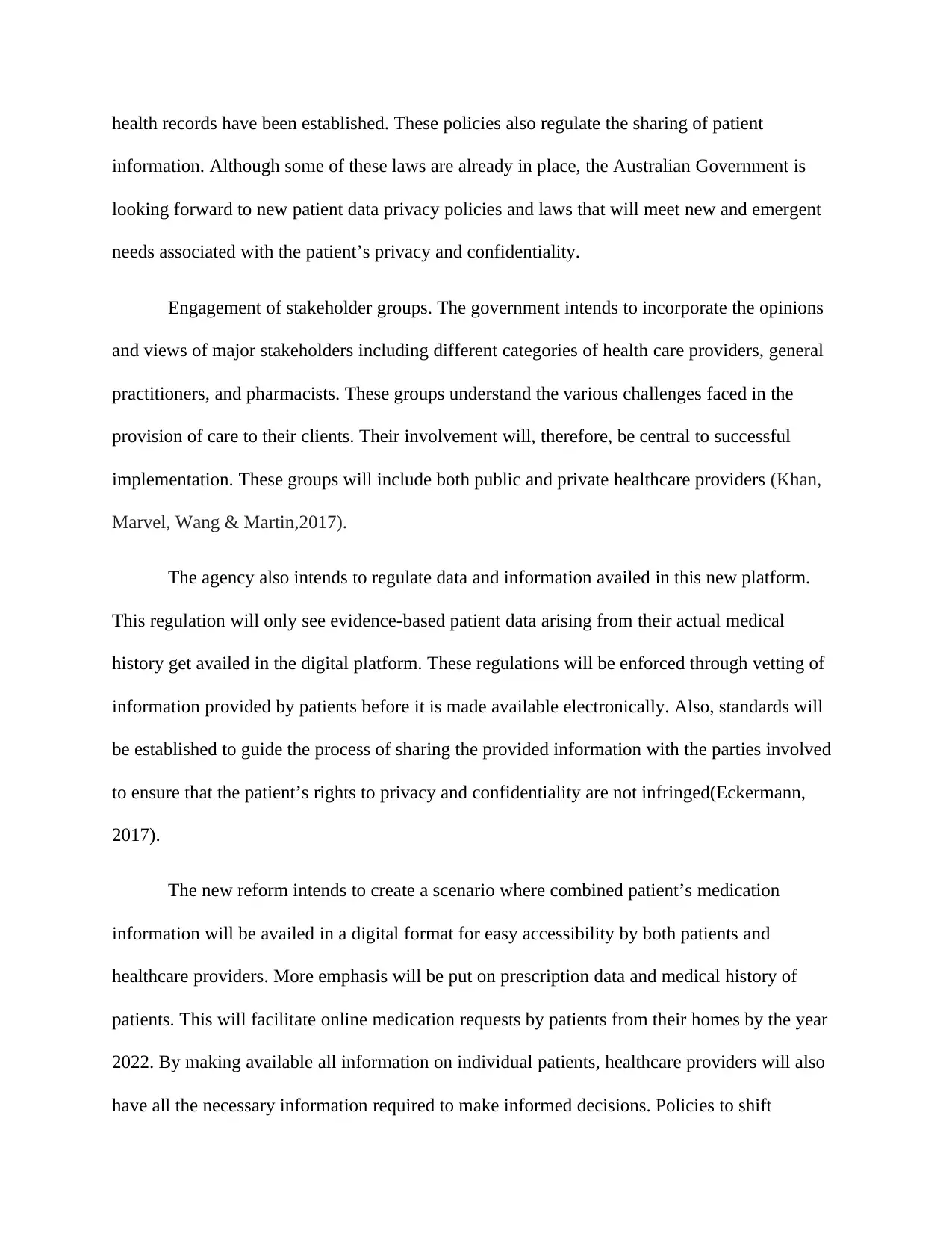
health records have been established. These policies also regulate the sharing of patient
information. Although some of these laws are already in place, the Australian Government is
looking forward to new patient data privacy policies and laws that will meet new and emergent
needs associated with the patient’s privacy and confidentiality.
Engagement of stakeholder groups. The government intends to incorporate the opinions
and views of major stakeholders including different categories of health care providers, general
practitioners, and pharmacists. These groups understand the various challenges faced in the
provision of care to their clients. Their involvement will, therefore, be central to successful
implementation. These groups will include both public and private healthcare providers (Khan,
Marvel, Wang & Martin,2017).
The agency also intends to regulate data and information availed in this new platform.
This regulation will only see evidence-based patient data arising from their actual medical
history get availed in the digital platform. These regulations will be enforced through vetting of
information provided by patients before it is made available electronically. Also, standards will
be established to guide the process of sharing the provided information with the parties involved
to ensure that the patient’s rights to privacy and confidentiality are not infringed(Eckermann,
2017).
The new reform intends to create a scenario where combined patient’s medication
information will be availed in a digital format for easy accessibility by both patients and
healthcare providers. More emphasis will be put on prescription data and medical history of
patients. This will facilitate online medication requests by patients from their homes by the year
2022. By making available all information on individual patients, healthcare providers will also
have all the necessary information required to make informed decisions. Policies to shift
information. Although some of these laws are already in place, the Australian Government is
looking forward to new patient data privacy policies and laws that will meet new and emergent
needs associated with the patient’s privacy and confidentiality.
Engagement of stakeholder groups. The government intends to incorporate the opinions
and views of major stakeholders including different categories of health care providers, general
practitioners, and pharmacists. These groups understand the various challenges faced in the
provision of care to their clients. Their involvement will, therefore, be central to successful
implementation. These groups will include both public and private healthcare providers (Khan,
Marvel, Wang & Martin,2017).
The agency also intends to regulate data and information availed in this new platform.
This regulation will only see evidence-based patient data arising from their actual medical
history get availed in the digital platform. These regulations will be enforced through vetting of
information provided by patients before it is made available electronically. Also, standards will
be established to guide the process of sharing the provided information with the parties involved
to ensure that the patient’s rights to privacy and confidentiality are not infringed(Eckermann,
2017).
The new reform intends to create a scenario where combined patient’s medication
information will be availed in a digital format for easy accessibility by both patients and
healthcare providers. More emphasis will be put on prescription data and medical history of
patients. This will facilitate online medication requests by patients from their homes by the year
2022. By making available all information on individual patients, healthcare providers will also
have all the necessary information required to make informed decisions. Policies to shift
Paraphrase This Document
Need a fresh take? Get an instant paraphrase of this document with our AI Paraphraser
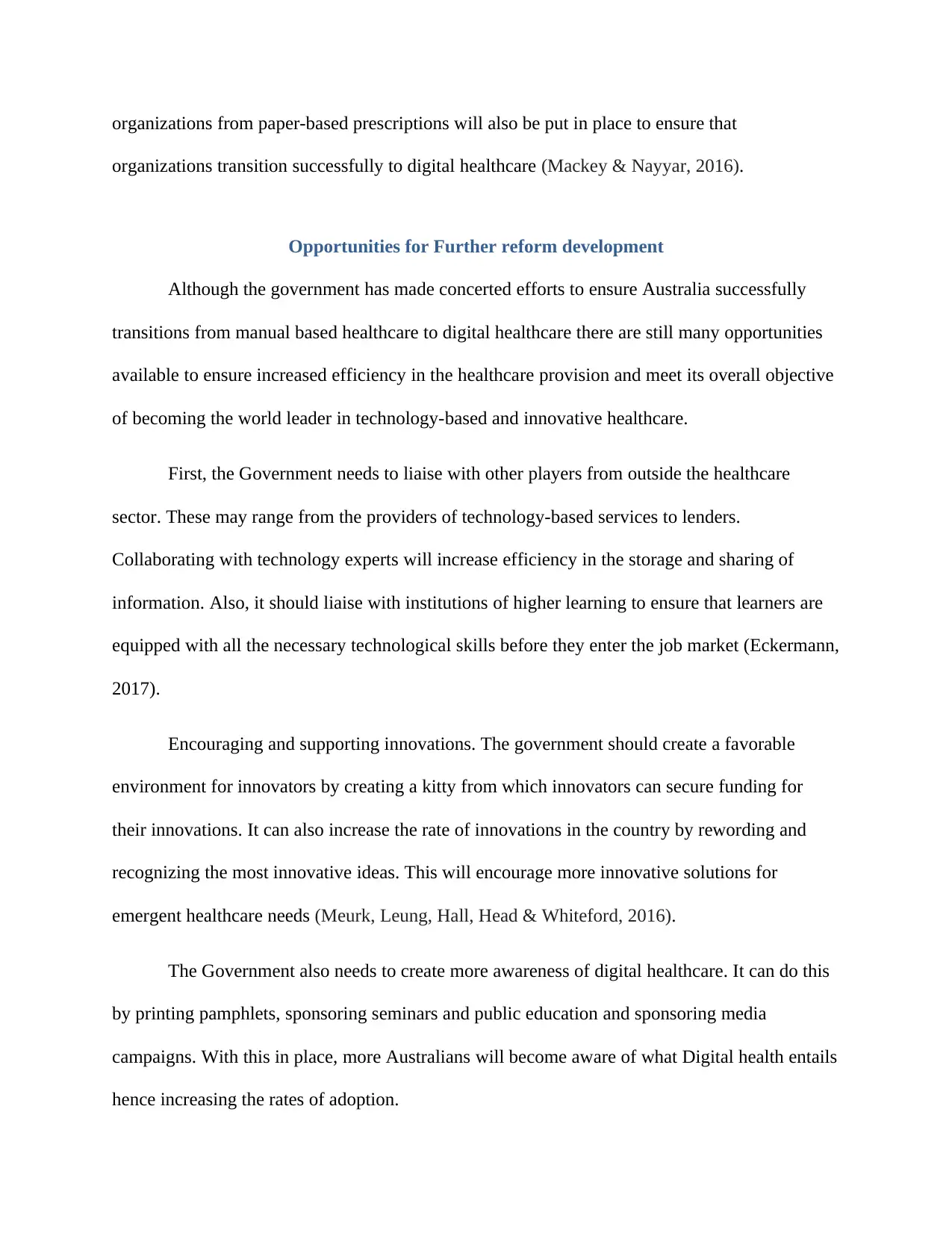
organizations from paper-based prescriptions will also be put in place to ensure that
organizations transition successfully to digital healthcare (Mackey & Nayyar, 2016).
Opportunities for Further reform development
Although the government has made concerted efforts to ensure Australia successfully
transitions from manual based healthcare to digital healthcare there are still many opportunities
available to ensure increased efficiency in the healthcare provision and meet its overall objective
of becoming the world leader in technology-based and innovative healthcare.
First, the Government needs to liaise with other players from outside the healthcare
sector. These may range from the providers of technology-based services to lenders.
Collaborating with technology experts will increase efficiency in the storage and sharing of
information. Also, it should liaise with institutions of higher learning to ensure that learners are
equipped with all the necessary technological skills before they enter the job market (Eckermann,
2017).
Encouraging and supporting innovations. The government should create a favorable
environment for innovators by creating a kitty from which innovators can secure funding for
their innovations. It can also increase the rate of innovations in the country by rewording and
recognizing the most innovative ideas. This will encourage more innovative solutions for
emergent healthcare needs (Meurk, Leung, Hall, Head & Whiteford, 2016).
The Government also needs to create more awareness of digital healthcare. It can do this
by printing pamphlets, sponsoring seminars and public education and sponsoring media
campaigns. With this in place, more Australians will become aware of what Digital health entails
hence increasing the rates of adoption.
organizations transition successfully to digital healthcare (Mackey & Nayyar, 2016).
Opportunities for Further reform development
Although the government has made concerted efforts to ensure Australia successfully
transitions from manual based healthcare to digital healthcare there are still many opportunities
available to ensure increased efficiency in the healthcare provision and meet its overall objective
of becoming the world leader in technology-based and innovative healthcare.
First, the Government needs to liaise with other players from outside the healthcare
sector. These may range from the providers of technology-based services to lenders.
Collaborating with technology experts will increase efficiency in the storage and sharing of
information. Also, it should liaise with institutions of higher learning to ensure that learners are
equipped with all the necessary technological skills before they enter the job market (Eckermann,
2017).
Encouraging and supporting innovations. The government should create a favorable
environment for innovators by creating a kitty from which innovators can secure funding for
their innovations. It can also increase the rate of innovations in the country by rewording and
recognizing the most innovative ideas. This will encourage more innovative solutions for
emergent healthcare needs (Meurk, Leung, Hall, Head & Whiteford, 2016).
The Government also needs to create more awareness of digital healthcare. It can do this
by printing pamphlets, sponsoring seminars and public education and sponsoring media
campaigns. With this in place, more Australians will become aware of what Digital health entails
hence increasing the rates of adoption.
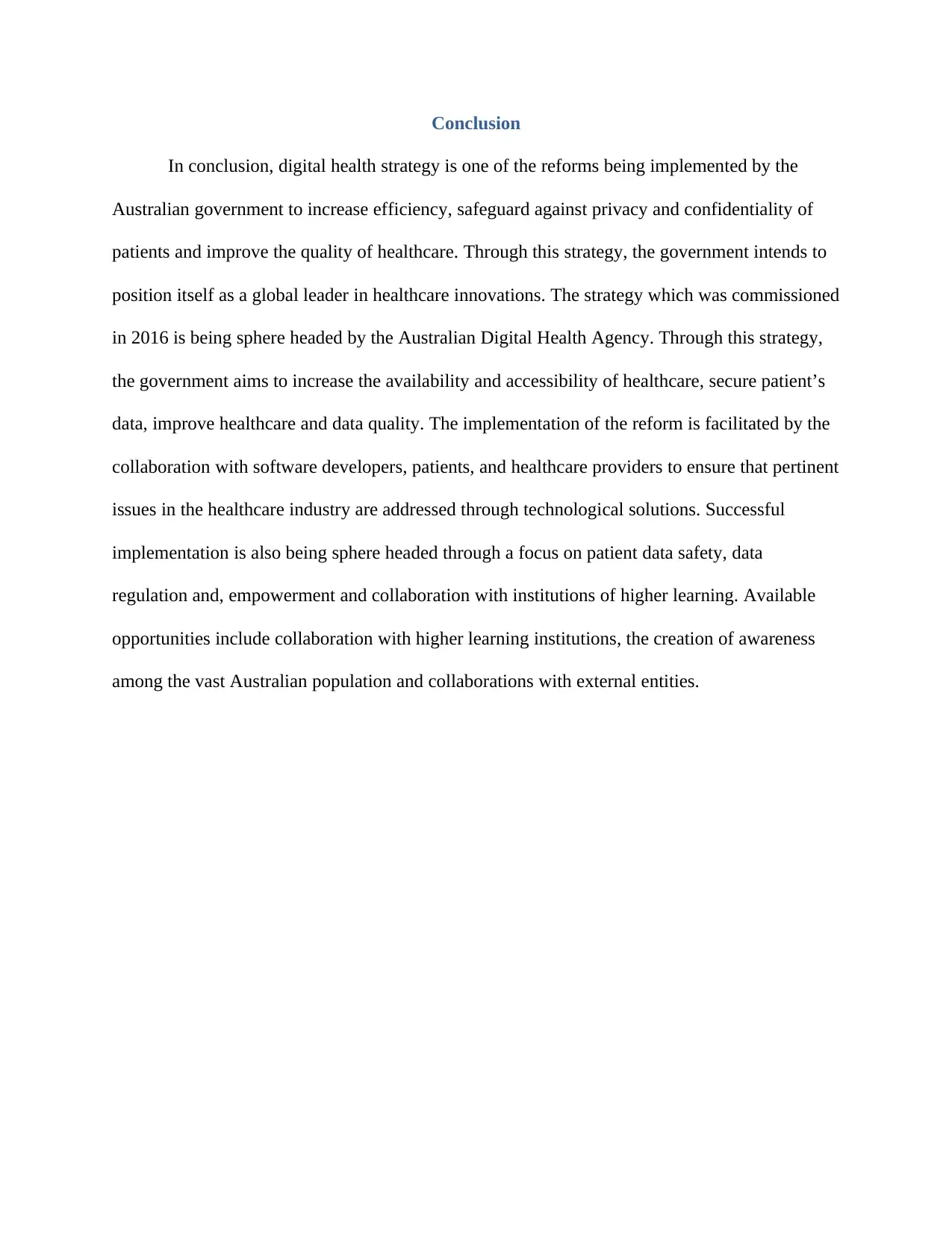
Conclusion
In conclusion, digital health strategy is one of the reforms being implemented by the
Australian government to increase efficiency, safeguard against privacy and confidentiality of
patients and improve the quality of healthcare. Through this strategy, the government intends to
position itself as a global leader in healthcare innovations. The strategy which was commissioned
in 2016 is being sphere headed by the Australian Digital Health Agency. Through this strategy,
the government aims to increase the availability and accessibility of healthcare, secure patient’s
data, improve healthcare and data quality. The implementation of the reform is facilitated by the
collaboration with software developers, patients, and healthcare providers to ensure that pertinent
issues in the healthcare industry are addressed through technological solutions. Successful
implementation is also being sphere headed through a focus on patient data safety, data
regulation and, empowerment and collaboration with institutions of higher learning. Available
opportunities include collaboration with higher learning institutions, the creation of awareness
among the vast Australian population and collaborations with external entities.
In conclusion, digital health strategy is one of the reforms being implemented by the
Australian government to increase efficiency, safeguard against privacy and confidentiality of
patients and improve the quality of healthcare. Through this strategy, the government intends to
position itself as a global leader in healthcare innovations. The strategy which was commissioned
in 2016 is being sphere headed by the Australian Digital Health Agency. Through this strategy,
the government aims to increase the availability and accessibility of healthcare, secure patient’s
data, improve healthcare and data quality. The implementation of the reform is facilitated by the
collaboration with software developers, patients, and healthcare providers to ensure that pertinent
issues in the healthcare industry are addressed through technological solutions. Successful
implementation is also being sphere headed through a focus on patient data safety, data
regulation and, empowerment and collaboration with institutions of higher learning. Available
opportunities include collaboration with higher learning institutions, the creation of awareness
among the vast Australian population and collaborations with external entities.
⊘ This is a preview!⊘
Do you want full access?
Subscribe today to unlock all pages.

Trusted by 1+ million students worldwide
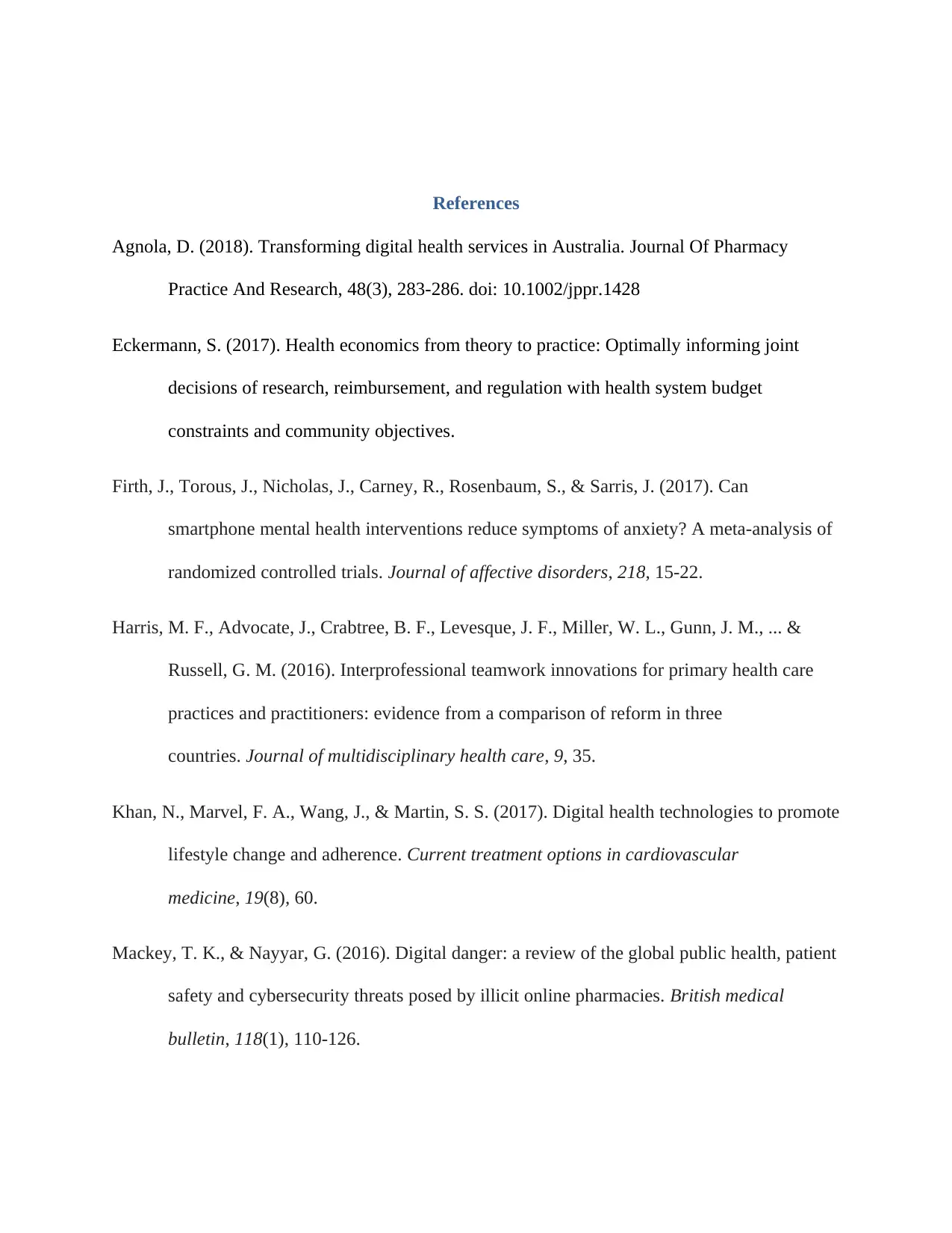
References
Agnola, D. (2018). Transforming digital health services in Australia. Journal Of Pharmacy
Practice And Research, 48(3), 283-286. doi: 10.1002/jppr.1428
Eckermann, S. (2017). Health economics from theory to practice: Optimally informing joint
decisions of research, reimbursement, and regulation with health system budget
constraints and community objectives.
Firth, J., Torous, J., Nicholas, J., Carney, R., Rosenbaum, S., & Sarris, J. (2017). Can
smartphone mental health interventions reduce symptoms of anxiety? A meta-analysis of
randomized controlled trials. Journal of affective disorders, 218, 15-22.
Harris, M. F., Advocate, J., Crabtree, B. F., Levesque, J. F., Miller, W. L., Gunn, J. M., ... &
Russell, G. M. (2016). Interprofessional teamwork innovations for primary health care
practices and practitioners: evidence from a comparison of reform in three
countries. Journal of multidisciplinary health care, 9, 35.
Khan, N., Marvel, F. A., Wang, J., & Martin, S. S. (2017). Digital health technologies to promote
lifestyle change and adherence. Current treatment options in cardiovascular
medicine, 19(8), 60.
Mackey, T. K., & Nayyar, G. (2016). Digital danger: a review of the global public health, patient
safety and cybersecurity threats posed by illicit online pharmacies. British medical
bulletin, 118(1), 110-126.
Agnola, D. (2018). Transforming digital health services in Australia. Journal Of Pharmacy
Practice And Research, 48(3), 283-286. doi: 10.1002/jppr.1428
Eckermann, S. (2017). Health economics from theory to practice: Optimally informing joint
decisions of research, reimbursement, and regulation with health system budget
constraints and community objectives.
Firth, J., Torous, J., Nicholas, J., Carney, R., Rosenbaum, S., & Sarris, J. (2017). Can
smartphone mental health interventions reduce symptoms of anxiety? A meta-analysis of
randomized controlled trials. Journal of affective disorders, 218, 15-22.
Harris, M. F., Advocate, J., Crabtree, B. F., Levesque, J. F., Miller, W. L., Gunn, J. M., ... &
Russell, G. M. (2016). Interprofessional teamwork innovations for primary health care
practices and practitioners: evidence from a comparison of reform in three
countries. Journal of multidisciplinary health care, 9, 35.
Khan, N., Marvel, F. A., Wang, J., & Martin, S. S. (2017). Digital health technologies to promote
lifestyle change and adherence. Current treatment options in cardiovascular
medicine, 19(8), 60.
Mackey, T. K., & Nayyar, G. (2016). Digital danger: a review of the global public health, patient
safety and cybersecurity threats posed by illicit online pharmacies. British medical
bulletin, 118(1), 110-126.
Paraphrase This Document
Need a fresh take? Get an instant paraphrase of this document with our AI Paraphraser
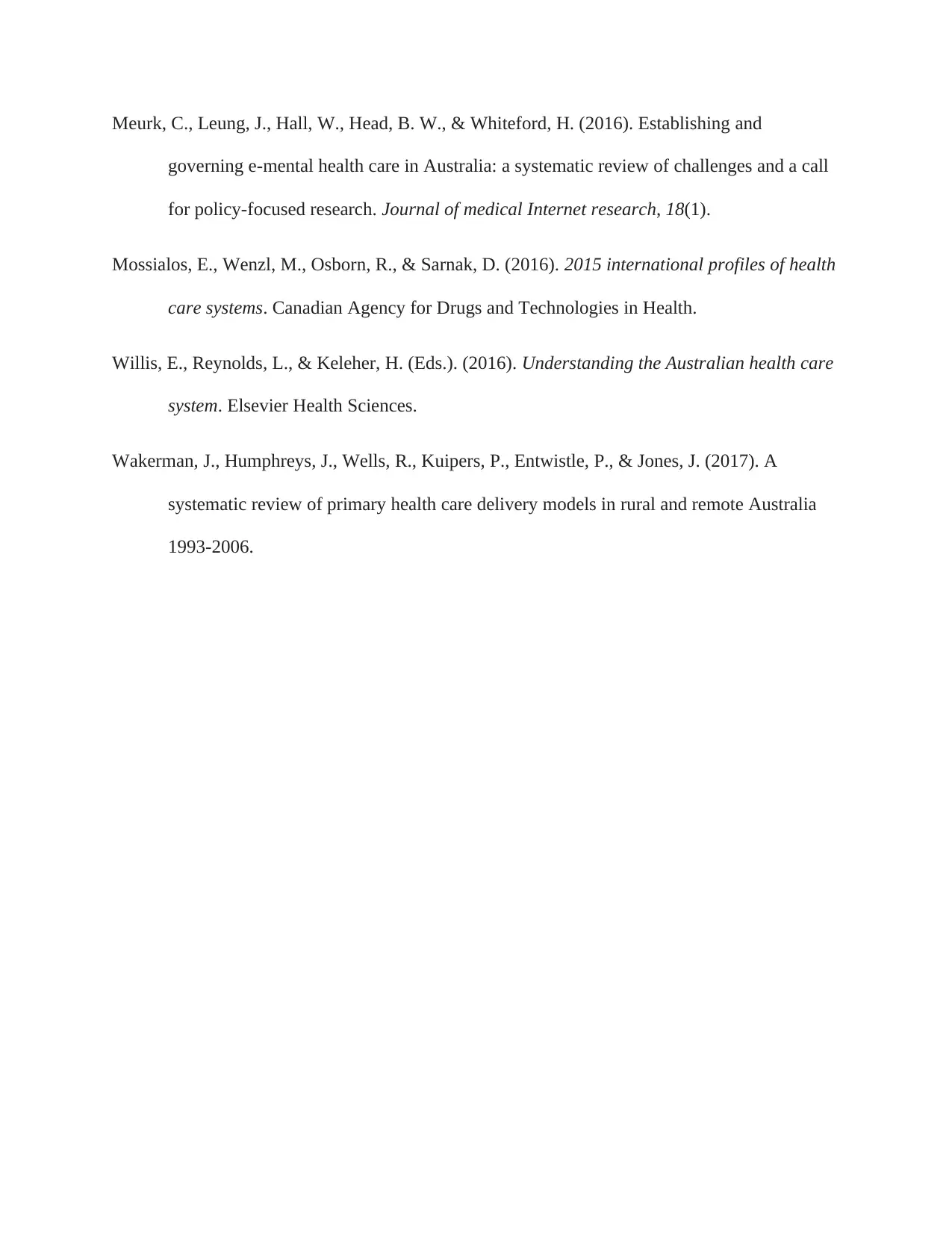
Meurk, C., Leung, J., Hall, W., Head, B. W., & Whiteford, H. (2016). Establishing and
governing e-mental health care in Australia: a systematic review of challenges and a call
for policy-focused research. Journal of medical Internet research, 18(1).
Mossialos, E., Wenzl, M., Osborn, R., & Sarnak, D. (2016). 2015 international profiles of health
care systems. Canadian Agency for Drugs and Technologies in Health.
Willis, E., Reynolds, L., & Keleher, H. (Eds.). (2016). Understanding the Australian health care
system. Elsevier Health Sciences.
Wakerman, J., Humphreys, J., Wells, R., Kuipers, P., Entwistle, P., & Jones, J. (2017). A
systematic review of primary health care delivery models in rural and remote Australia
1993-2006.
governing e-mental health care in Australia: a systematic review of challenges and a call
for policy-focused research. Journal of medical Internet research, 18(1).
Mossialos, E., Wenzl, M., Osborn, R., & Sarnak, D. (2016). 2015 international profiles of health
care systems. Canadian Agency for Drugs and Technologies in Health.
Willis, E., Reynolds, L., & Keleher, H. (Eds.). (2016). Understanding the Australian health care
system. Elsevier Health Sciences.
Wakerman, J., Humphreys, J., Wells, R., Kuipers, P., Entwistle, P., & Jones, J. (2017). A
systematic review of primary health care delivery models in rural and remote Australia
1993-2006.
1 out of 11
Related Documents
Your All-in-One AI-Powered Toolkit for Academic Success.
+13062052269
info@desklib.com
Available 24*7 on WhatsApp / Email
![[object Object]](/_next/static/media/star-bottom.7253800d.svg)
Unlock your academic potential
Copyright © 2020–2025 A2Z Services. All Rights Reserved. Developed and managed by ZUCOL.




